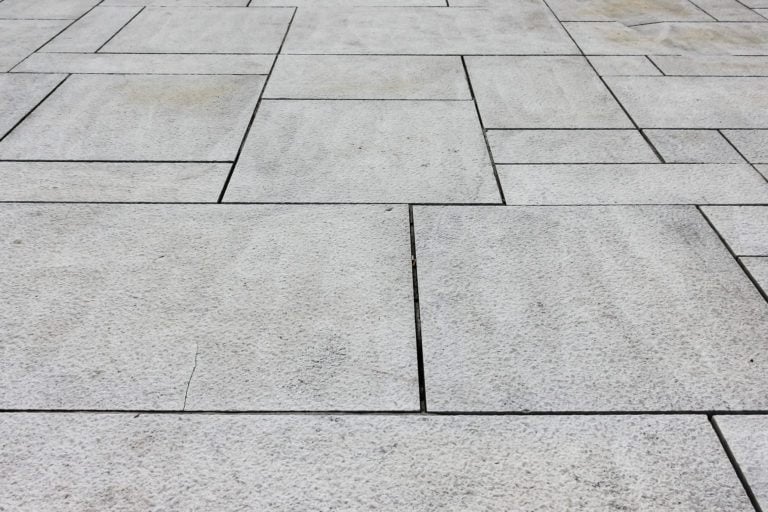
Quick Tips
- Make haste.
- Sweep regularly.
- Washing stone.
- Rinsing clean stone.
- Drying stone.
- Call in the pros.
I am drawn to things that, like myself, are full of natural beauty. For this reason, when I’m all growed up and own my own house, I have every intention of furnishing it with natural stone. I’m talking stone countertops, stone-tiled bathrooms, a stone fireplace (hopefully) and yes, even stone floors. There’s just nothing quite like it. As far as I’m concerned, stone is the only building material that allows a home to simultaneously induce feelings of both luxury and modesty.
As with anything of great beauty, a fair share of work must go into maintaining it. While I have allowed laziness and various other poor life choices to diminish a fair share of my own personal natural beauty, that sort of neglect is simply unacceptable when it comes to maintaining stone. While I’m pretty easily replaceable, all that glorious stone in your home is not. Nor would you want it to be. Properly maintained stone can and should last a lifetime. That’s a hefty part of why we’re drawn to it. The only problem is that many people, whether they bought a home with stonework or had it installed themselves, simply don’t know how to clean natural stone. That’s where I come in. As someone who’s been looking into home ownership, I’ve also been looking into different materials and their upkeep. And you know what? Stone seems to be a winner. While this article focuses primarily on cleaning natural stone floors, I will explain within the steps below how a slight variation in technique will work quite well for cleaning stone-tiled walls as well.
Steps to Cleaning Stone
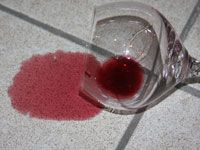 Make haste. It is extremely important when cleaning stone to get to spills as quickly as humanly possible. Stone is porous, and the longer spills are allowed to sit on them, the more time is allowed for the stone to soak them up. This can lead to stains that can be very difficult to remove. So, when something spills, blot it up immediately with the absorbent material of your choice. Just make sure to blot, not wipe. You don’t want to spread the spill around to be absorbed by the surrounding stone. If something has splattered onto a wall, use your absorbent material to roll the spill off. This is done by rotating your hand as you wipe so there is always a clean section of towel for the spill to soak into. Skip to the third step in this section to learn how to wash stone after you’ve blotted up the spill.
Make haste. It is extremely important when cleaning stone to get to spills as quickly as humanly possible. Stone is porous, and the longer spills are allowed to sit on them, the more time is allowed for the stone to soak them up. This can lead to stains that can be very difficult to remove. So, when something spills, blot it up immediately with the absorbent material of your choice. Just make sure to blot, not wipe. You don’t want to spread the spill around to be absorbed by the surrounding stone. If something has splattered onto a wall, use your absorbent material to roll the spill off. This is done by rotating your hand as you wipe so there is always a clean section of towel for the spill to soak into. Skip to the third step in this section to learn how to wash stone after you’ve blotted up the spill.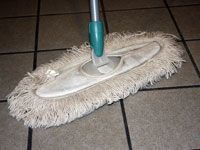 Sweep regularly. I know it seems pretty commonsensical, but when it comes to cleaning stone floors, sweeping is a tad more important than it is with other types of flooring. The problem is that stone’s annoying little cousin, sand, is quite abrasive and will eventually leave tiny little scratches all over your stone tile floor. Sweep your floors twice a week at the very least; more if needed. Also, do yourself a favor and, if you don’t already have one, get yourself a dust mop. It will cut your sweeping time in half. Whether sweeping or mopping, get someone to help you move furniture. Dragging furniture across the floor is the quickest way to make your floor look like crap, especially if the dragging is done before sweeping and sand gets stuck under the feet of the furniture.
Sweep regularly. I know it seems pretty commonsensical, but when it comes to cleaning stone floors, sweeping is a tad more important than it is with other types of flooring. The problem is that stone’s annoying little cousin, sand, is quite abrasive and will eventually leave tiny little scratches all over your stone tile floor. Sweep your floors twice a week at the very least; more if needed. Also, do yourself a favor and, if you don’t already have one, get yourself a dust mop. It will cut your sweeping time in half. Whether sweeping or mopping, get someone to help you move furniture. Dragging furniture across the floor is the quickest way to make your floor look like crap, especially if the dragging is done before sweeping and sand gets stuck under the feet of the furniture.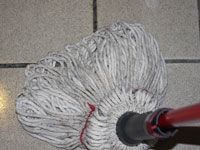 Washing stone. Without question, the easiest way to clean stone floors is with a mop. No surprise there. The thing many people fail to realize is that you should use a pH-neutral stone cleaner in your mop water. Acids, even weak ones, have a tendency to etch stone and wear down grout. It won’t be immediately noticeable, but over time, acids can discolor and weaken stone. So what should you use as a stone cleaner? Any clear pH-neutral dish soap. I highly recommend adding a couple tablespoons of Seventh Generation or Method dish detergent to your mop water. For wiping walls down, use the same thing, but mix it in a bucket and use a clean rag for wiping. If your stone is looking good but your grout is needing a little extra attention, check out Amber’s article on How to Clean Grout.
Washing stone. Without question, the easiest way to clean stone floors is with a mop. No surprise there. The thing many people fail to realize is that you should use a pH-neutral stone cleaner in your mop water. Acids, even weak ones, have a tendency to etch stone and wear down grout. It won’t be immediately noticeable, but over time, acids can discolor and weaken stone. So what should you use as a stone cleaner? Any clear pH-neutral dish soap. I highly recommend adding a couple tablespoons of Seventh Generation or Method dish detergent to your mop water. For wiping walls down, use the same thing, but mix it in a bucket and use a clean rag for wiping. If your stone is looking good but your grout is needing a little extra attention, check out Amber’s article on How to Clean Grout.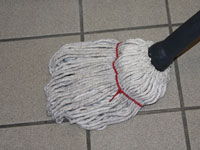 Rinsing clean stone. I’m willing to bet that after all that mopping you thought you were all done cleaning stone. Well, guess again. I’m sorry to break it to you, but there are still a couple steps to go. After mopping with your stone cleaner, empty your mop bucket, rinse it out really well, rinse out your mop, and fill the bucket back up with fresh warm water. It’s now time to go over the entire floor again. By mopping with fresh water, you help to ensure against the streaking that is often left behind from cleaning products. It also helps you get any missed sand or debris. In order to keep your rinse water clean, change it several times throughout the process. For rinsing stone walls, use fresh water in a bucket with a fresh, clean rag for wiping.
Rinsing clean stone. I’m willing to bet that after all that mopping you thought you were all done cleaning stone. Well, guess again. I’m sorry to break it to you, but there are still a couple steps to go. After mopping with your stone cleaner, empty your mop bucket, rinse it out really well, rinse out your mop, and fill the bucket back up with fresh warm water. It’s now time to go over the entire floor again. By mopping with fresh water, you help to ensure against the streaking that is often left behind from cleaning products. It also helps you get any missed sand or debris. In order to keep your rinse water clean, change it several times throughout the process. For rinsing stone walls, use fresh water in a bucket with a fresh, clean rag for wiping.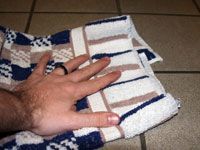 Drying stone. Congrats; you are now the proud owner of clean natural stone. Too bad—still not done. But if it makes you feel any better, this is the last thing you should have to do. It also just happens to be the most unpleasant. While it might be extremely tempting to allow your stone floor to air dry, it’s not the best idea you’ve ever had. By allowing the stone to air dry, you’re just asking for water spots. The best way to avoid this is to grab a few old towels and dry the floor by hand. Like I said, it’s not a whole lotta fun, but it beats the hell out of buffing water spots out later. Which, incidentally, can be done with a soft towel and some elbow grease.
Drying stone. Congrats; you are now the proud owner of clean natural stone. Too bad—still not done. But if it makes you feel any better, this is the last thing you should have to do. It also just happens to be the most unpleasant. While it might be extremely tempting to allow your stone floor to air dry, it’s not the best idea you’ve ever had. By allowing the stone to air dry, you’re just asking for water spots. The best way to avoid this is to grab a few old towels and dry the floor by hand. Like I said, it’s not a whole lotta fun, but it beats the hell out of buffing water spots out later. Which, incidentally, can be done with a soft towel and some elbow grease.- Call in the pros. Sometimes stone floors and stone walls get soiled beyond the point where mere mortals are still able to clean them. Maybe it was caused by a really bad spill or maybe it was just the accumulation of filth over a long period of time. I guess it doesn’t really matter. All you need to know is that there is help. Either check the phone book or do a quick Google search for stone cleaning services in your area. These people have skills. They have special products, know special secrets and have special stone cleaning magics for drawing out (or pushing down) stains that you thought were going to be visible forever.
Should Natural Stone be Sealed?
Sealing stone floors is a subject of great debate. On the one hand, sealing stone makes it considerably easier to care for. It sweeps easier, cleans easier, and doesn’t hold onto stains like unsealed stone does. Also, contrary to what most people think, sealing stone does not generally mean slathering a thick layer of goo over your floor. It’s actually quite difficult to tell the difference between sealed and unsealed stone floors. Most stone sealants are designed to impregnate the stone and just fill its pores without building up on the surface. What this does is provide you with a little more time to get to spills before they stain your stone. On the other hand…well, there really isn’t much of an other hand. While some people will get mad at me for saying this because of the slight possibility of a slight discoloration of your stone, just seal it. The first time something colorful gets spilled on it, you’ll be glad you did.
Organic Stone Cleaners
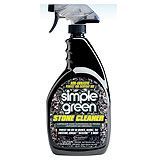 Simple Green Stone Cleaner is a non-toxic, biodegradable, natural stone cleaner that is safe enough for everyday use on your stone surfaces. It is nonabrasive and can be used on any number of stone surfaces, including granite, marble, quartz, sandstone, porcelain, ceramic and more. Simple Green also makes a stone polish that can be used in conjunction with the cleaner. You can order bottles of Simple Green Stone Cleaner from Amazon.
Simple Green Stone Cleaner is a non-toxic, biodegradable, natural stone cleaner that is safe enough for everyday use on your stone surfaces. It is nonabrasive and can be used on any number of stone surfaces, including granite, marble, quartz, sandstone, porcelain, ceramic and more. Simple Green also makes a stone polish that can be used in conjunction with the cleaner. You can order bottles of Simple Green Stone Cleaner from Amazon.
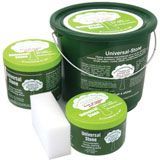 Universal Stone, besides the fact that it is made in Germany, which automatically makes it cool, is a 100% biodegradable and eco-friendly cleaner. It’s made from all natural ingredients and is acid-free. While it is perfectly safe for taking stains out of stone surfaces, it can also be used on anything else you’ve got a mind to clean.
Universal Stone, besides the fact that it is made in Germany, which automatically makes it cool, is a 100% biodegradable and eco-friendly cleaner. It’s made from all natural ingredients and is acid-free. While it is perfectly safe for taking stains out of stone surfaces, it can also be used on anything else you’ve got a mind to clean.
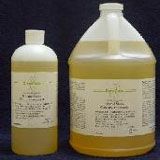 100% Organic Natural Stone Cleaner Concentrate, made by DuraCare Products and available through QMI Environmental, is exactly what the name implies. This stuff is great for floors, walls, countertops, masonry, imitation stone, stucco, ceramic, porcelain, grout, concrete and more. Once you’ve used their natural stone cleaner, they’ve also got a ready-to-use penetrating sealer.
100% Organic Natural Stone Cleaner Concentrate, made by DuraCare Products and available through QMI Environmental, is exactly what the name implies. This stuff is great for floors, walls, countertops, masonry, imitation stone, stucco, ceramic, porcelain, grout, concrete and more. Once you’ve used their natural stone cleaner, they’ve also got a ready-to-use penetrating sealer.